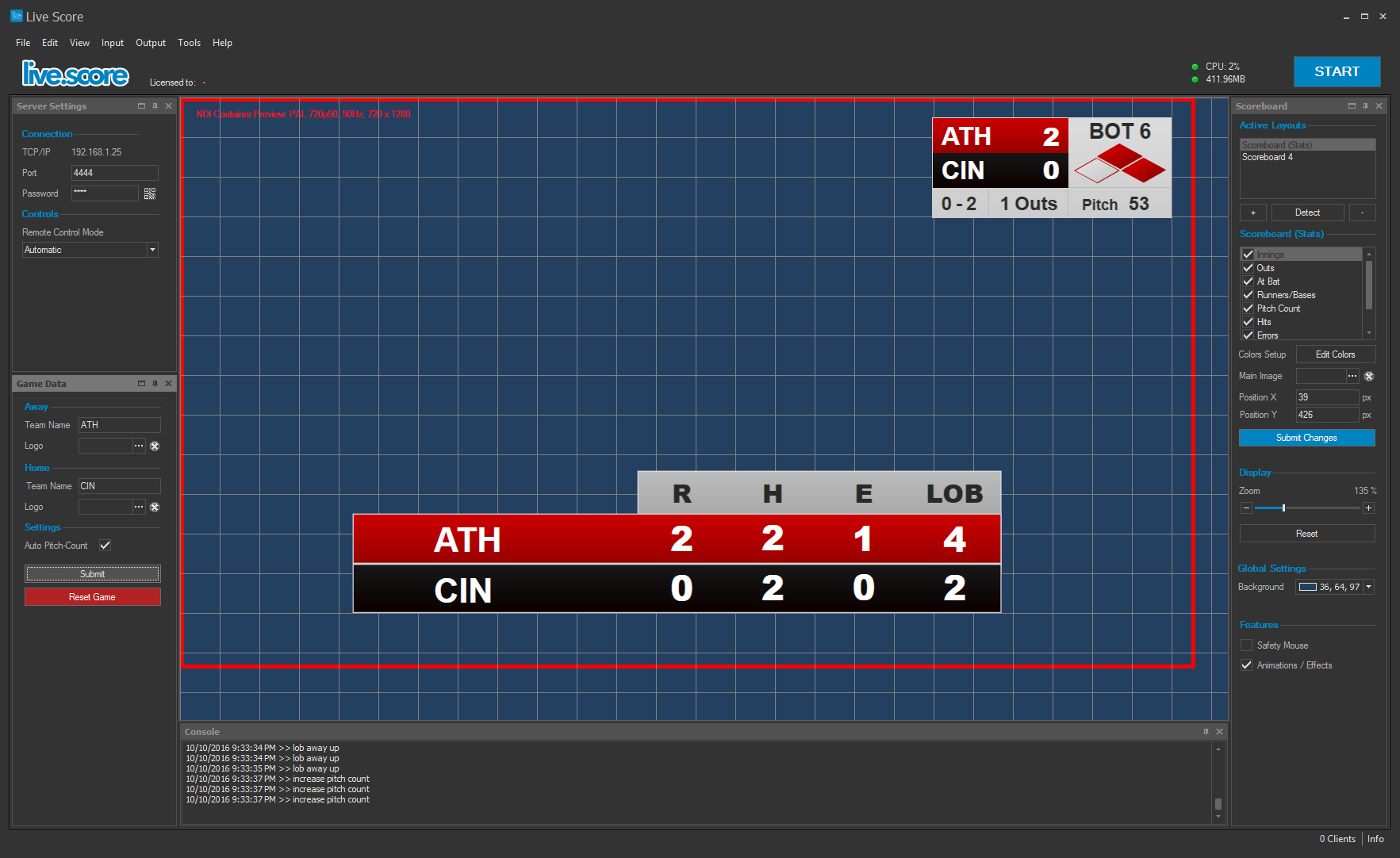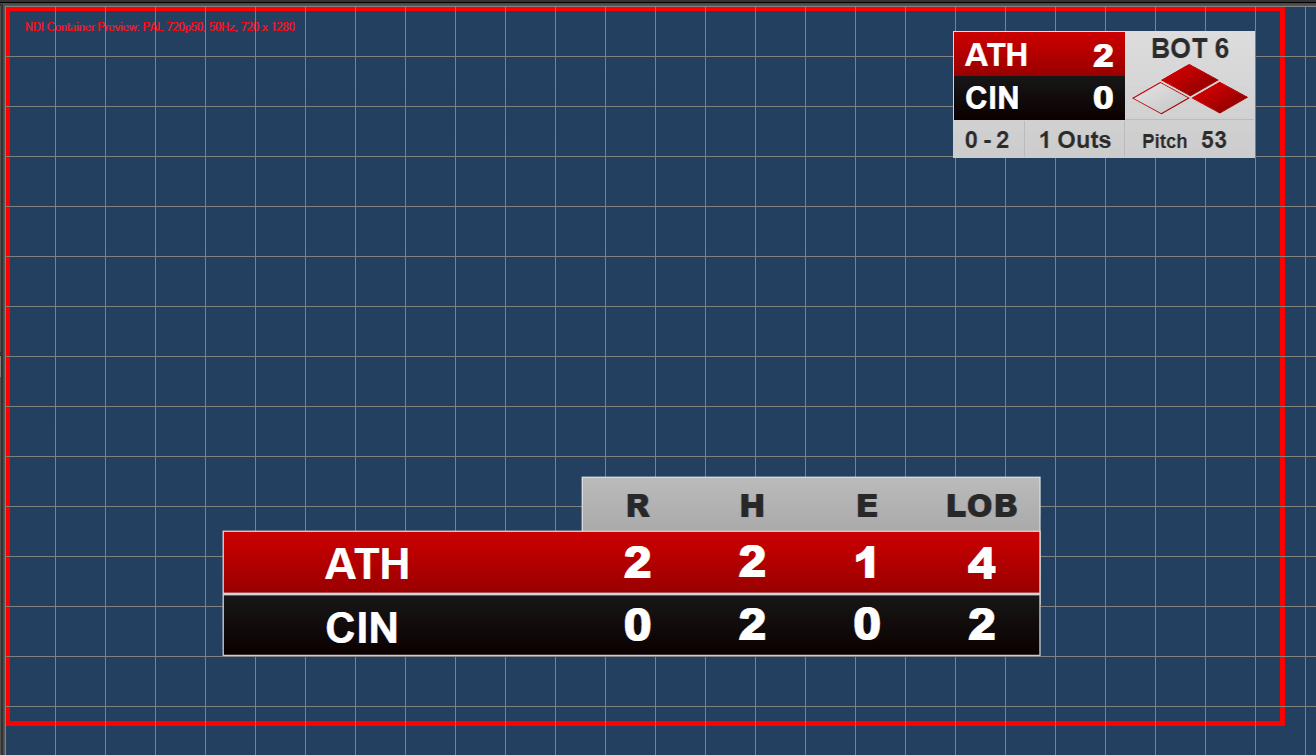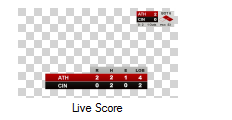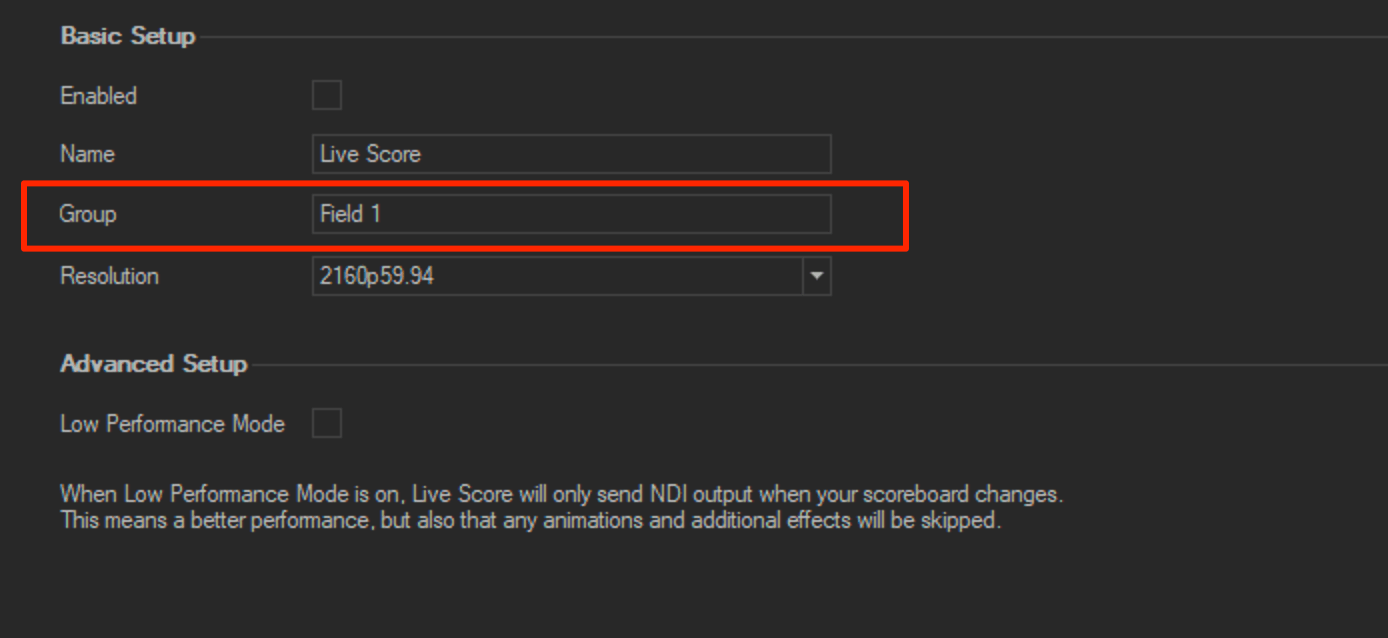
NewTek NDI Output
Run Live Score on your computer, laptop or Windows tablet in your local network. When using NDI, you're Live Score PC will be automatically detected as a local NDI source and can be added easily to any NDI compatible streaming software.
Setup NDI Container
We start by setting up our NDI Container.
The NDI Container is the part of your scoreboard area, that will be sent to your local network. Go to the Settings dialog from your menu bar (Edit -> Settings) and open the Newtek NDI page from the sidebar.
Enable NDI output and set your name, how you want your output to appear in your other NDI compatible applications.
You can then choose from predefined resolution settings.
GPU decoding makes sure that your GPU is used instead of your CPU when NDI is used. If your computer is not eligible for GPU decoding it will use your CPU instead.
If you have a computer with a lower performance, you can optionally enable the Low Performance Mode. If enabled, Live Score will only send a single frame after your scoreboard data has changed.
The NDI Container is the part of your scoreboard area, that will be sent to your local network. Go to the Settings dialog from your menu bar (Edit -> Settings) and open the Newtek NDI page from the sidebar.
Enable NDI output and set your name, how you want your output to appear in your other NDI compatible applications.
You can then choose from predefined resolution settings.
GPU decoding makes sure that your GPU is used instead of your CPU when NDI is used. If your computer is not eligible for GPU decoding it will use your CPU instead.
If you have a computer with a lower performance, you can optionally enable the Low Performance Mode. If enabled, Live Score will only send a single frame after your scoreboard data has changed.
Please note that no animations will be sent if Low Performance Mode is enabled.
Align your Layouts
If NDI has been enabled, you will see a red NDI Container rectangle if the Live Score engine is
stopped.
The content within this container will be sent to your network.
Depending on what resolution you have selected in the NDI settings, it has a different width and height.
You can now start to align and position your scoreboards within that rectangle.
Depending on your workflow, this container helps you to set the final position of your scoreboard in your streaming software, or directly in Live Score.
The content within this container will be sent to your network.
Depending on what resolution you have selected in the NDI settings, it has a different width and height.
You can now start to align and position your scoreboards within that rectangle.
Depending on your workflow, this container helps you to set the final position of your scoreboard in your streaming software, or directly in Live Score.
Start the NDI Output
You can start the broadcasting through NDI by simply pressing the blue start button in the upper right
corner of Live Score.
Using the NDI Broadcast
Now start your NDI compatible broadcasting software.
If you open your NDI input sources, you should now see the network broadcast from the Live Score application.
The broadcast comes without any background, so no additional chroma keying is required.
If you have already set the correct positions of the layouts within the NDI container, you should already have the perfect setting for your stream. Otherwise feel free to adjust position and scaling from within your streaming software.
If you open your NDI input sources, you should now see the network broadcast from the Live Score application.
The broadcast comes without any background, so no additional chroma keying is required.
If you have already set the correct positions of the layouts within the NDI container, you should already have the perfect setting for your stream. Otherwise feel free to adjust position and scaling from within your streaming software.
NDI Groups
If you have lots of NDI streams and productions in your network, NDI groups help you to better organize your NDI data.
An example would be, if you have multiple fields and courts where games are being streamed. Every field has its own bunch of different graphics and overlays that are received with NDI. In this case, you can use groups to organize your fields.
There could be a group "Field 1", "Field 2", and more.
Every computer that belongs to a specific field, needs to be configured to listen to that NDI group of that field.
If you want to use groups, then 2 things are important.
Start by chosing any group name you want (or one that you already agreed on), and configure it in Live Score within the NDI settings. Then simply start the NDI broadcast in Live Score.
To receive the NDI broadcast in your receiving instance, you have to make sure the receiving computer listens to that NDI group.
Install the NDI Tools on that computer and start the Access Manager.
Open the Groups section and add a new group.
Make sure to name it exactly as within Live Score.
Submit your changes and open your NDI receiver application.
You should now be able to find the Live Score NDI broadcast from the specified NDI group.
An example would be, if you have multiple fields and courts where games are being streamed. Every field has its own bunch of different graphics and overlays that are received with NDI. In this case, you can use groups to organize your fields.
There could be a group "Field 1", "Field 2", and more.
Every computer that belongs to a specific field, needs to be configured to listen to that NDI group of that field.
If you want to use groups, then 2 things are important.
Start by chosing any group name you want (or one that you already agreed on), and configure it in Live Score within the NDI settings. Then simply start the NDI broadcast in Live Score.
To receive the NDI broadcast in your receiving instance, you have to make sure the receiving computer listens to that NDI group.
Install the NDI Tools on that computer and start the Access Manager.
Open the Groups section and add a new group.
Make sure to name it exactly as within Live Score.
Submit your changes and open your NDI receiver application.
You should now be able to find the Live Score NDI broadcast from the specified NDI group.
To have a NDI broadcast without any groups, just leave the group field empty in Live Score!







